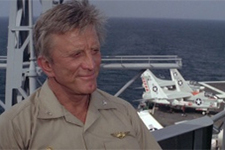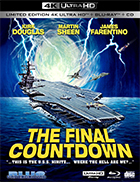The Final Countdown (4K UHD) [Blu-Ray]
|

While Kirk Douglas and Martin Sheen are the above-the-title stars of the cult sci-fi curiosity The Final Countdown, the film's real star is the nuclear-powered supercarrier USS Nimitz (CVN-68), on which most of the film's action is set, thus giving it more screen time than any of the human actors. When the film was released, the state-of-the-art Nimitz had been in commission for about five years and was one of the largest warships in the world (as it is still in active duty, it has now become the oldest U.S. aircraft carrier still in service). The Nimitz is truly something to behold: a gargantuan floating military base covered with F-14s and carrying more than a thousand service men. Its presence on-screen constantly threatens to turn The Final Countdown into a military documentary, and at times it feels like one, as we watch fighter jet after fight jet take off and land on her deck in rhythmic succession. The hundreds of millions of dollars of military gear on-screen gives The Final Countdown the visual allure of a mega-budget studio film, when it was, in fact, a low-budget independent production cobbled together by young upstarts led by first-time producer, Peter Douglas, Kirk's son, and associate producer Lloyd Kaufman, who had previously worked only on low-budget B-movies with titles like Silent Night, Bloody Night (1972) and Les Nympho Teens (1976). The script by David Ambrose (D.A.R.Y.L.) and Gerry Davis (Doctor Who) and Thomas Hunter and Peter Powell (The ‘Human' Factor), is essentially an extended Twilight Zone episode funded by the military. The USS Nimitz, while conducting maneuvers in the waters off Hawaii, is sucked into a time vortex during a sudden storm and spit out four decades earlier on December 6, 1941—the day before the Japanese attack Pearl Harbor (thankfully, there is no labored attempt to explain the time warp or where it came from). It doesn't take terribly long for the ship's captain, Capt. Matthew Yelland (Kirk Douglas), to figure out what has happened, at which point he and his fellow officers (including James Farentino's Cdr. Richard Owens and Ron O'Neal's Cdr. Dan Thurman, as well as Martin Sheen's Warren Lasky, a civilian efficiency expert working for the Department of Defense) to grapple with their options, namely whether or not they should use the advanced capabilities and awesome firepower of a modern warship and its fighter jets to thwart the sneak attack they know is coming. It seems like a no-brainer—after all, who wouldn't want to stop a foreign attack that they know will kill thousands?—but then they realize that such a choice could have massive ramifications for the rest of human history. Douglas's Capt. Yelland is a stalwart commander, a pinnacle of resolve, calm, and thoughtfulness (you can see why the U.S. military, after suffering through the previous two decades of Vietnam-related negative PR, was so anxious to throw its support behind the film). He and the other officers weigh their options with significant care, which allows us time to wrestle with our own views on what they should do and what the consequences might be. The film has some fun with some of its supporting characters, particularly a blowhard Senator with White House aspirations named Samuel Chapman (Charles Durning) whose weekend pleasure boat is blown out of the water by Japanese planes seeking to eliminate anyone who might warn Pearl Harbor of their presence. He and his administrative assistant, a smart and self-aware woman named Laurel Scott (Katharine Ross), are picked up the Nimitz and must deal with their own time-warp experience (when told they are onboard the USS Nimitz, Senator Chapman rightly points out that there is no such ship, as its namesake, World War II Pacific fleet commander Chester W. Nimitz, was still very much alive and at work). The Final Countdown was directed by Don Taylor, who began his career as an actor in the early 1940s before moving behind the camera in the mid-1950s, primarily in television, where he directed episodes of more than 50 series and various made-for-television movies. He directed a handful of theatrical features in the 1970s, notably Escape From the Planet of the Apes (1971), the musical Tom Sawyer (1973), The Island of Dr. Moreau (1977), and Damien: Omen II (1978), the latter two of which gave him experience working with Hollywood studio era veterans Burt Lancaster and William Holden. His work on The Final Countdown is largely functional, as he essentially cedes any sense of style to a simple documenting of the impressive presence of military hardware, which is well shot by workman cinematographer Victor J. Kemper (Dog Day Afternoon, The Eyes of Laura Mars). The Final Countdown is a unique merging of military drama and science fiction, and even if it doesn't always work, it presents such a fascinating scenario that you can't help but get sucked into its swirling vortex of unending and paradoxical "what if's?."
Copyright © 2021 James Kendrick Thoughts? E-mail James Kendrick All images copyright © Blue Underground | |||||||||||||||||||||||||||||
Overall Rating:



 (3.5)
(3.5)
Subscribe and Follow
Get a daily dose of Africa Leader news through our daily email, its complimentary and keeps you fully up to date with world and business news as well.
News RELEASES
Publish news of your business, community or sports group, personnel appointments, major event and more by submitting a news release to Africa Leader.
More Information
